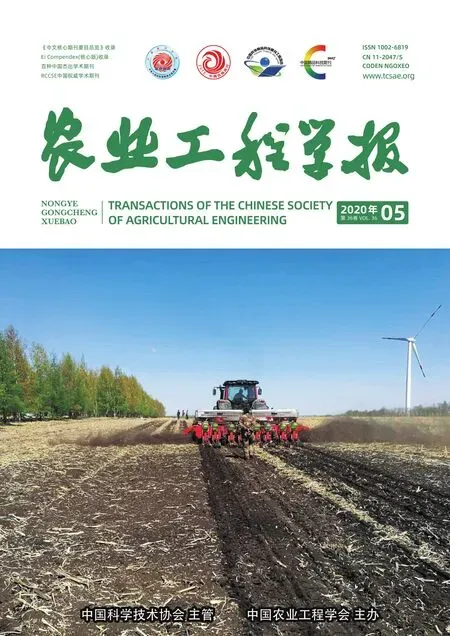转轴型孔式精量排种器充种性能仿真分析与试验
2020-04-24李娟娟张和平毕新胜李姝卓
李娟娟,张和平,毕新胜,王 剑,胡 斌,李姝卓
转轴型孔式精量排种器充种性能仿真分析与试验
李娟娟1,张和平2,毕新胜1※,王 剑1,胡 斌1,李姝卓1
(1. 石河子大学机械电气工程学院,石河子 832000;2. 新疆科农机械制造有限责任公司,奎屯 834000)
针对转轴型孔式棉花精量排种器在充种过程中由于型孔未囊取种子而造成漏播的问题,该研究通过建立棉种充填过程的运动学模型对相互抢位的棉种进行力学分析,研究取种轮运动参数与排种器转速对充种性能的影响。应用离散元仿真软件分析落入型孔的棉种速度的变化趋势,并分析取种轮振动频率对种群扰动的影响,以取种轮振动频率、取种轮振动偏移角、排种器转速为试验因素,以排种粒距合格率、重播率、漏播率为试验指标,进行三因素五水平的正交通用旋转组合试验,探究各因素对排种性能的影响,运用Design Expert 8.0.6软件对试验结果进行分析,并对回归模型进行优化验证。仿真分析结果表明,棉种瞬时速度随着排种轮转速的提高而增加,仿真标记的棉种在充入型孔时的瞬时速度小于取种轮速度,而相对取种轮速度较小的棉种具有更好的充种性能;在7 Hz时,种群法向力平均值最小,即种群的内摩擦力最小,棉种易于被型孔囊取;当排种器转速为12.59 r/min,取种轮振动偏移角度为8.06°,振动频率为6.08 Hz时,排种器的排种粒距合格率达到最大值94.5%。在此基础上,以新陆早61号棉花种子为试验对象进行台架验证试验,试验结果表明,当排种器转速为12 r/min时,排种器的排种粒距合格率达到最大值94.65%,漏播指数随着排种器转速的增加呈上升趋势,重播率随着转速的增加呈现下降趋势,与优化结果基本吻合,验证了仿真结果的准确性。该研究可为转轴型孔式棉花精量排种器关键部件结构优化设计提供参考。
农业机械;优化;试验;EDEM;精量排种器;充种性能
0 引 言
机械式棉花精量排种器因具有结构简单、排种均匀等优点被广泛应用于精密播种技术,其充种过程是整个排种器工作过程中关键的环节[1-3],而型孔附件的种子的运动参数和作业参数设置对排种器的作业质量有重要影响[4-7]。
随着计算机技术发展的迅速,近年来许多学者应用离散元法及数值模拟软件(EDEM)对排种器工作性能进行研究分析[8-10]。李政权等[11]以内充种式排种器和小麦种子为研究对象,采用EDEM分析内充种式排种器工作过程和性能。于建群等[12]运用离散元法分析排种器工作时种子的运动过程和排种器的清种性能。廖庆喜等[13]通过离散元法,对离心式排种器的充种过程进行研究,分析了内锥筒种量与临界转速的关系、排种器转速与总排种量的关系。刘涛等[14]借助离散元分析软件对3种型孔结构的窝眼轮式油菜排种器进行模拟分析,并进行试验验证,结果表明型孔结构对种子群扰动影响明显,且种子群扰动量越大充种性能越好。韩丹丹等[15-16]以离散元法为基础,采用键合颗粒模型对玉米进行建模,并采用EDEM-CFD耦合分析方法模拟不同吸孔安装位置对充填工作性能的影响。孙裕晶等[17]基于CAD边界模型的离散元设计分析方法,建立精密排种器部件和种子群联合模型,对常压下大豆精密排种过程进行动态仿真分析。丁力等[18]运用离散元软件研究不同种盘对种群的扰动情况,通过仿真试验分析得出设计种盘能够有效增强种群离散程度。张昆等[19]采用离散元分析的方法,对种层高度、振动频率、振动角度分别进行数值模拟,结果表明:通过减小内摩擦、增强种群扰动性、提高供种高度措施可提高排种器充种性能。赖庆辉等[20]基于离散元法,对排种器充种过程进行仿真分析,结果表明:增加振动频率和振动幅度可以增大种子平均法向力方差,增强对种子的扰动性,从而提高充种性能。上述研究表明,种群的运动特性对排种器的充种性能具有较为重要的影响,提高充种区充种性能是提高排种器的排种性能的有效方法,但在充种过程中种子间会出现挤压、碰撞和拖带等现象,如果处理不当会使得种子无法充入型孔,造成重播或者漏播现象,严重影响排种器的工作性能。
鉴于此,本文以项目组前期研制的转轴型孔式棉花精量排种器为研究对象,建立棉种充种过程的动力学模型,分析充种过程中取种轮的运动参数及排种器转速对充种性能的影响。在此基础上,利用EDEM软件进行充种性能的数值模拟,研究型孔在囊取棉种的过程中种子的运动规律,并利用Expert 8.0.6软件对数值模拟结果进行分析。最后通过台架试验验证结果的合理性,以期获得利于充种的最佳工作参数,降低漏播率。
1 排种器结构与工作原理
1.1 排种器结构
如图1所示,转轴型孔式棉花精量排种器主要由进料筒、透视盖、左定盘、挡盘、模块夹圈、取种模块(包括壳体、拐臂、清种刷、取种轮和弹簧)、齿板、排种轴、鸭嘴、腰带、右定盘等组成。其中取种模块7安装在模块夹圈6的卡槽内,取种轮通过拐臂与弹簧安装于取种模块7,齿板5与挡盘4通过螺钉进行固定。其中腰带直径321 mm,模块夹圈外圈直径317 mm,内圈直径313 mm。
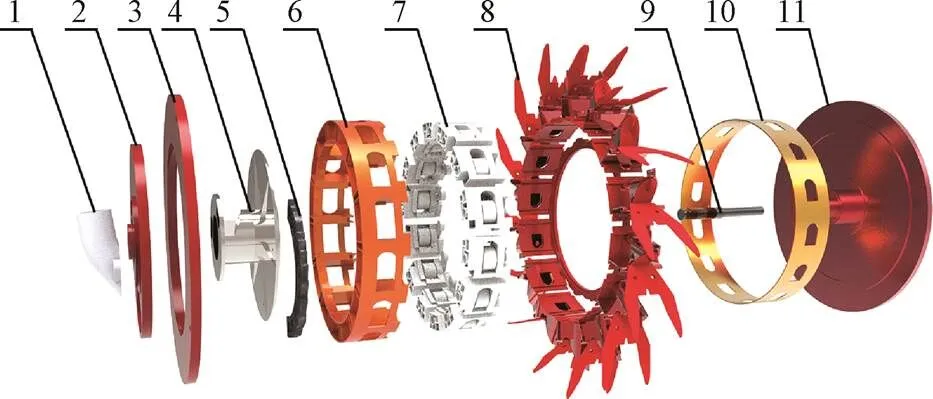
1.进料筒 2.透视盖 3.左定盘 4.挡盘 5.齿板 6.模块夹圈 7.取种模块 8.鸭嘴 9.排种轴 10.腰带 11.右定盘
1.2 工作原理
如图2a所示,转轴型孔式棉花精量排种器按工作区域划分为充种区、清种区、携种区、一次投种区、二次投种区。其作业原理如图2b所示,棉种由进料口进入充种区后形成种子群,在动力驱动下取种模块跟随夹圈进行回转运动,取种模块内拐臂与齿板上齿形的滚动接触带动取种轮进行旋转运动,棉种与取种轮间产生相对运动,棉种在重力、离心力及种子间相互作用力下充入取种轮上的型孔(非通孔);当拐臂与齿板上的齿形滚动接触运动结束时,取种轮在弹簧恢复力的作用下进行旋转运动,型孔周围多余棉种在重力与清种刷的作用下回到充种区;随型孔运动到一次投种区的棉种在重力、离心力、摩擦力及型孔面支持力的作用下落入储种腔,储种腔内的棉种在取种模块的回转运动下被运送至二次投种区,棉种落入鸭嘴内,并在重力作用下完成投种作业;如此循环完成连续播种过程。
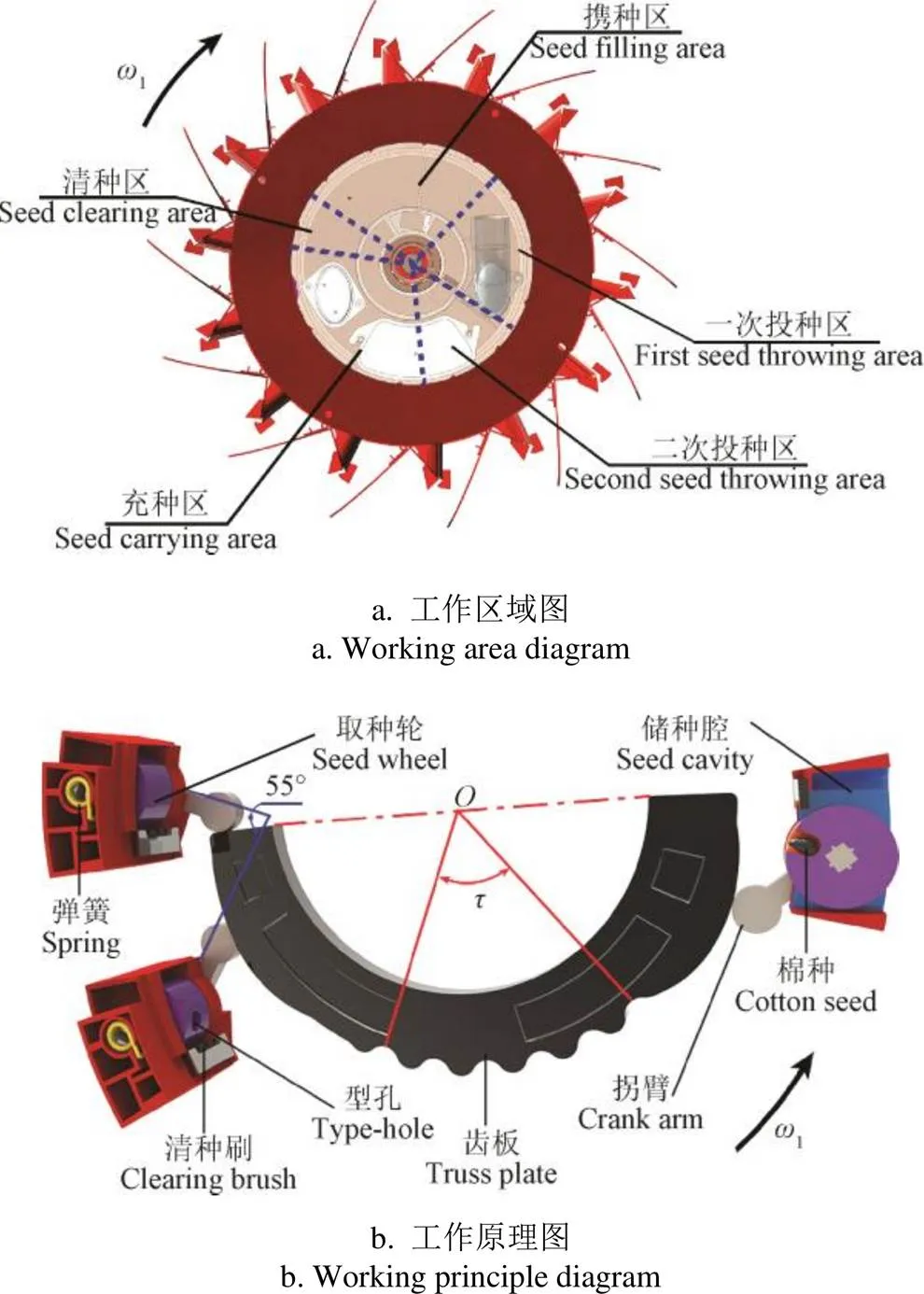
注:ω1为排种器的角速度,rad·s-1;τ为取种轮振动运动区域对应的圆心角度数,(°)。
2 棉种充种过程分析
充种区内的种子群运动受多种因素的影响,各层种子的运动复杂多变,种子能否充入型孔取决于种群与取种轮的相对运动情况,因此对取种轮运动特性的研究尤为重要[21]。充种区内取种轮的运动轨迹方程为

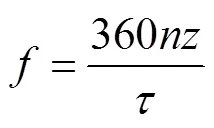
式中为取种轮简谐运动位移,mm;为取种轮振动幅值,mm;为排种器转速,r/min;为齿板齿数;为取种轮振动频率,Hz;为时间,min。
2.1 棉种充入型孔的运动学分析
型孔参数是排种器设计的关键,本文设计的型孔形状为长圆柱形,型孔前缘有引种倒角有利于种子充入型孔,型孔后缘有退种倒角,有利于棉种退出型孔。其直径为9.94 mm,深度为8.47 mm,型孔前端与后端倒角宽度为5 mm。
种子能否充入型孔取决于其相对于型孔的速度,为便于分析棉种充入型孔时的速度变化情况,以单粒棉种为研究对象,以棉种长轴方向为轴,垂直于轴为轴,忽略空气阻力影响[22]。棉种落入型孔瞬间的运动状态如图3所示。

注:D为型孔直径,mm;H为型孔深度,mm;B为倒角宽度,mm;l为棉种长轴半径,mm;h为棉种短轴半径,mm。
对取种轮的运动轨迹求时间的一阶导数得到取种轮的速度:

当棉种以极限速度max充入型孔时,其质心沿轴方向做匀速运动,沿轴方向做自由落体运动,其运动轨迹方程为



取种轮的速度0为其正弦运动速度与圆周运动速度v的矢量和:

1=2π(8)

棉种相对于取种轮的速度等于棉种速度1与取种轮速度0矢量和[23]。保证播种精度的条件是:棉种相对于取种轮的速度必须小于囊取棉种所需要棉种的极限速度,即

式(4)~(10)中,为取种轮的振动幅值,mm;为棉种质心落到取种面的时间,s;为重力加速度,m/s2,1为排种器的圆周运动角速度,rad/s;为夹圈半径,mm。
通过对棉种充种过程的运动学分析可知:当型孔直径、倒角宽度、棉种几何参数、夹圈半径、排种器圆周运动的角速度和取种轮振动幅值等参数已知时,棉种的瞬时充种概率与取种轮振动频率及排种器转速有关。
2.2 抢位棉种的受力分析
棉种充入型孔的过程是一个复杂的受力过程,种子间、种子与型孔表面的滑动摩擦、滚动摩擦、正压力、重力等共同作用构成一个不断变化的动态力学系统[24]。在充种过程中,造成空穴的一个主要原因是棉种在充种区起拱、相互抢位[25]。为便于从理论角度分析棉种的抢位现象,以单粒棉种为分析对象,忽略种群上层棉种的作用力,瞬时平衡状态下相互占位的2粒棉种在取种轮上的受力情况如图4所示,对棉种1进行受力分析,以其与取种轮的切线方向为轴,垂直于切线方向为轴。

注:Nf为取种轮对棉种1的支持力,N;Fi为取种轮对棉种1的摩擦力,N;Fr为棉种的离心力,N;G为棉种的重力,N;N为棉种2对棉种1的支持力,N;Ff为棉种2对棉种1的摩擦力,N;α为棉种2对棉种1的支持力与x轴的夹角,(°);β为取种轮振动偏移角(棉种1的重力方向与y轴的夹角),(°)。
由图4可知:





式中,1为取种轮与棉种之间的摩擦系数;2为棉种与棉种之间的摩擦系数。
当棉种2的加速度a沿轴正方向时,棉种2抢位成功,落入型孔,棉种1落回到充种室,此时棉种2在轴方向产生加速度,该棉种的受力如公式(16)所示。

相互抢位棉种的力学分析表明,当取种轮振动偏移角发生变化时,棉种将获得沿轴方向的加速度,增加棉种充入型孔的概率。
2.3 一次投种区的棉种受力分析
图5为棉种在一次投种区的受力分析图。当取种轮跟随夹圈运动至一次投种区时,型孔内的棉种在重力、摩擦力、离心力、支持力的共同作用下落入储种腔。若棉种在一次投种区未能掉入储种腔,随着取种轮的转动位于型孔内的棉种会再次落回充种室而无法落入储种室,从而造成漏播现象。
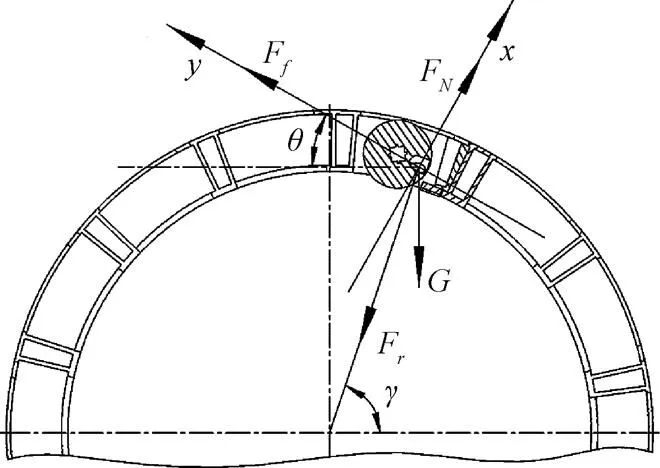
注:FN为型孔面对棉种的支持力,N;θ为与棉种接触的型孔面与水平面的夹角,(°);γ为棉种质心与排种器中心连线与水平面之间的夹角,(°)。
根据图5可知:




=(21)
式中为单个棉种的质量,g;1为棉种质心与排种器中心的距离,mm。
棉种完成一次投种的必要条件为

由以上分析可知,当棉种质量、排种器圆周运动角速度、棉种质心到排种器的中心距离、棉种与型孔之间的摩擦系数一定时,棉种质心与水平面的夹角和型孔面与水平方向的夹角决定了棉种能否下落到储种腔。当棉种在一次投种区不能落入储种腔时,在进入二次投种区后将没有棉种落入鸭嘴,从而造成漏播现象。
3 排种器仿真模型建立
EDEM仿真软件在农业工程领域得到广泛应用,可模拟排种机构与颗粒物料间相互作用后种子的运动状态和机械特性[26],为探究排种器转速、取种轮振动频率、取种轮振动偏移角度对排种性能的影响,本文应用EDEM软件开展二次回归通用旋转组合仿真试验,探讨取种轮运动参数与排种器转速对排种器排钟性能的影响。
3.1 仿真参数确定
排种器的壳体材料为45#钢板,取种部件的材料为尼龙塑料,其物理参数与材料间的接触参数如表1、表2所示。

表1 材料的物理特性参数

表2 材料间的接触参数
3.2 棉种三轴尺寸的测定
本文以100粒新陆早61号棉种为研究对象,分别测量其三轴尺寸,结果如表3所示。由表3可知,新陆早61号棉种的长度尺寸大于宽度和厚度尺寸,棉种在厚度尺寸上的差异性要大于其在长度和宽度尺寸上的差异性。对棉种的三轴尺寸进行KS检验,结果表明棉种的长、宽、厚的显著性指标值均大于0.05,因此可认为棉种三轴尺寸近似服从正态分布。

表3 棉种三轴尺寸
采用Hangdyscan型扫描仪对棉种进行三维扫描[27],将获得的棉种三维模型另存为X-T格式,并导入EDEM中,如图6所示。
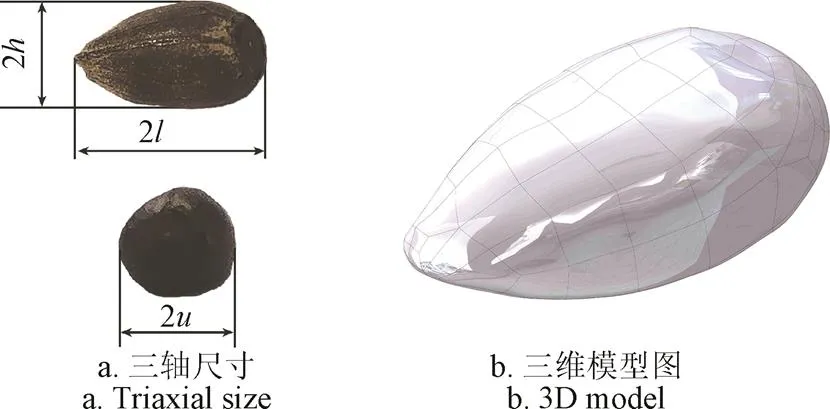
注:u为棉种厚度,mm。
3.3 仿真参数设置
为提高仿真精度、缩短计算周期,将排种器零部件简化为前挡盘、模块夹圈、取种轮、后挡盘和进料筒,设定颗粒工厂生产颗粒总数为2 000个。为保证仿真的连续性,设置固定时间步长为1.95×10-2ms,Rayleith时间步长百分比设置为15%,仿真时间为15 s。排种器仿真模型如图7所示。
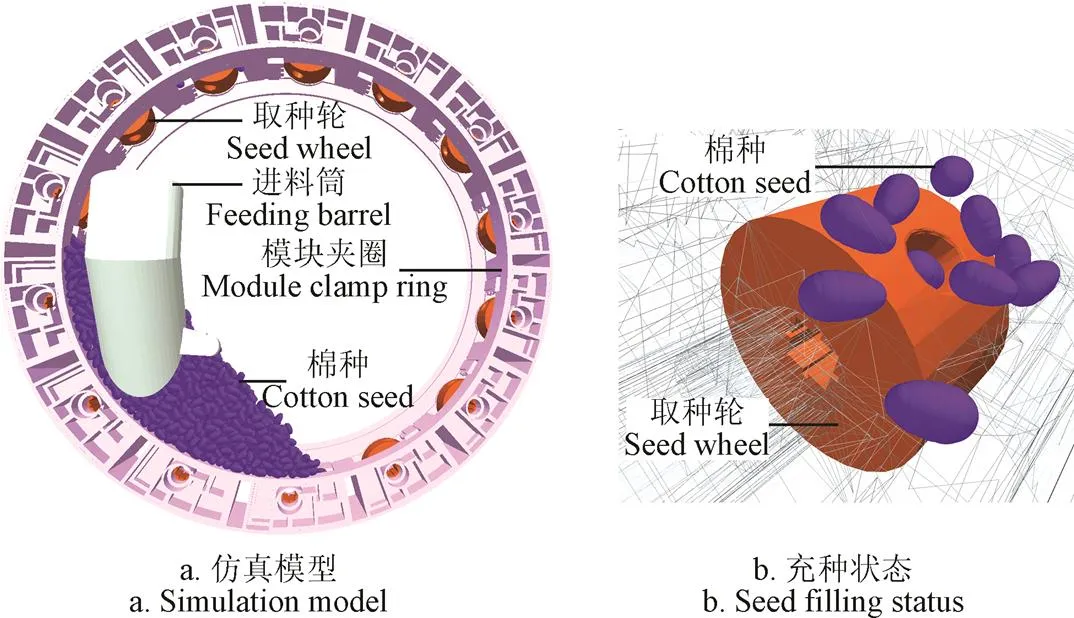
图7 排种器仿真模型
4 仿真试验结果与分析
4.1 单因素仿真试验与结果分析
4.1.1 取种轮振动频率对种群法向力的影响
取种轮振动频率对种群具有扰动作用,在一定范围内随着振动频率的增加,种群的扰动强度增大,导致棉种间的瞬时法向应力降低,其中棉种间的法向应力可以衡量棉种间的内摩擦力,而较小的内摩擦力有利于棉种充入型孔,但随着振动频率持续增加会增加棉种间的拖带与碰撞作用,造成棉种的充填性能降低,因此研究不同振动频率下种群法向力变化趋势对提高排种器充种性能具有重要意义[28]。为降低排种器转速对种群平均法向力的影响,将排种器转速设置为较低的转速,确定排种器转速在8~15 r/min;选取齿板齿数在3~10个范围内,计算出相应的取种轮振动频率为2~12 Hz,为提高种群的扰动强度,降低种子间的拖带和碰撞作用,选用小于10 Hz的振动频率[29]。最终确定以取种轮的振动频率3、7和10 Hz,排种器转速为8、10和15 r/min进行单因素试验。图8为棉种所受的平均法向力随时间的变化趋势。

注:取种轮振动偏移角为8°;排种器转速为10 r·min-1。
Note: Vibration deviation angle of seed wheel is 8°; the speed of the seed-metering device is 10 r·min-1.
图8 不同取种轮振动频率下的种群法向力
Fig.8 Normal force of seeds under different vibration frequency of seed wheel
由图8可知,棉种所受的法向力随时间变化呈现无规律状态,且随着取种轮振动频率的增大,法向力波动范围增大,相邻法向力峰值的时间间隔缩短。取种轮振动频率为3 Hz时,其对应的法向力方差平均值为0.19,取种轮振动频率为7 Hz时,其对应的法向力方差平均值为0.22,取种轮振动频率为10 Hz时,其对应的法向力方差平均值为0.24,方差越大表明其种群离散程度越大,对种群扰动性越大,使棉种处于有利充种状态。种群法向力减小,其内摩擦力减小,棉种容易从种群中脱离,而被型孔囊取。由图8e可知,当取种轮振动频率由3 Hz增加到7 Hz时,种群法向力平均值由0.77 N降低至0.75 N,当取种轮振动频率由7 Hz增加到10 Hz时,种群法向力平均值由0.75 N提高至0.87 N,因此当取种轮振动频率为7 Hz时,种群法向力平均值最小为0.75 N,即种群的内摩擦力最小,棉种易于被型孔囊取,排种器的充种性能提高。
4.1.2 充入型孔的棉种速度分析
为探究棉种在充入型孔时的速度变化趋势,将取种轮振动偏移角设置为8°,取种轮振动频率设置为7 Hz,分别以排种器转速8、10和15 r/min进行仿真试验。当排种器转速为8 r/min时,标记该试验条件下具有充入型孔趋势的棉种,编号分别为376、842和855。当排种器转速为10 r/min时编号分别为96、132和345。当排种器转速为15 r/min时编号为624、910和967。依次获取棉种与取种轮速度数据,将其导入Origin中进行绘图,不同转速下3粒棉种的速度变化趋势如图9所示。其中A点与B点的横坐标值表示棉种充入型孔的时刻,纵坐标值表示该时刻取种轮与棉种的速度值。
由图9a可知,排种器转速为8 r/min时,376,842和855号棉种充入型孔的时间分别为14.7、12.88和12.27 s,其速度分别为0.058、0.063和0.048 m/s,取种轮的速度分别为0.069、0.086和0.070 m/s。在该转速下,棉种的速度波动范围(0.005~0.339 m/s)较小,且在大部分时间内小于取种轮速度。
由图9b可知,排种器转速为10 r/min时,396,132和345号棉种充入型孔的时间分别为2.27、2.42和7.88 s,其速度别为0.073、0.085和0.093 m/s,取种轮的速度分别为0.096、0.092和0.113 m/s。与8 r/min的转速相比,该转速下棉种的速度波动范围(0.012~0.384 m/s)增大,且小于取种轮速度的时间减少。
由图9c可知,排种器转速为15 r/min时,624,910和967号棉种充入型孔的时间分别为12.88、8.03和9.55 s,其速度别为0.070、0.139和0.114 m/s,此时取种轮的速度分别为0.139、0.153和0.129 m/s。与前2种排种器转速相比,该转速下棉种的速度波动范围(0.014~0.619 m/s)呈现持续增大趋势,且棉种速度小于取种轮速度的时间进一步减少。

注:取种轮的振动偏移角为8°,振动频率为7 Hz。
通过上述分析可知,在同一排种器转速下棉种的速度变化杂乱无章,但随着排种器转速的提高,棉种瞬时速度呈现增加趋势,仿真所标记的棉种在充入型孔时的瞬时速度小于取种轮的瞬时速度,且棉种在充入型孔前后,速度波动较大。此外,具有较小相对速度的棉种表现出更好的充种效果,这与王业成的研究结果相符[30]。因此可以通过改变排种器转速,进而改变棉种的相对速度,获取较小的棉种相对于取种轮的速度,从而提高棉种的充填概率,为排种器工作参数的确定提供依据。
4.2 二次通用旋转组合仿真试验与结果分析
通过上述分析可知,取种轮的振动频率、排种器转速、取种轮振动偏移角影响排种器的排种性能。为探究各影响因素对排种性能的影响规律,设计二次回归通用旋转组合试验(星号臂长度=1.682、试验次数为20次),通过仿真试验,确定获得最优排种性能下的最优参数组合。根据单因素试验结果,结合前期田间试验和参考文献[1-4],选取齿板齿数范围为3~10 个,计算出相应的取种轮振动频率范围为2~12 Hz,同时为提高种群的扰动强度,降低种子间的拖带和碰撞作用,选用小于10 Hz的振动频率,最终确定取种轮的振动频率范围为3~10 Hz。为降低排种器转速对种群的影响,因此将排种器转速设置为低速,确定排种器的转速范围为8~15 r/min,确定取种轮振动偏移角为5°≤2≤12°,因素水平编码如表4所示。
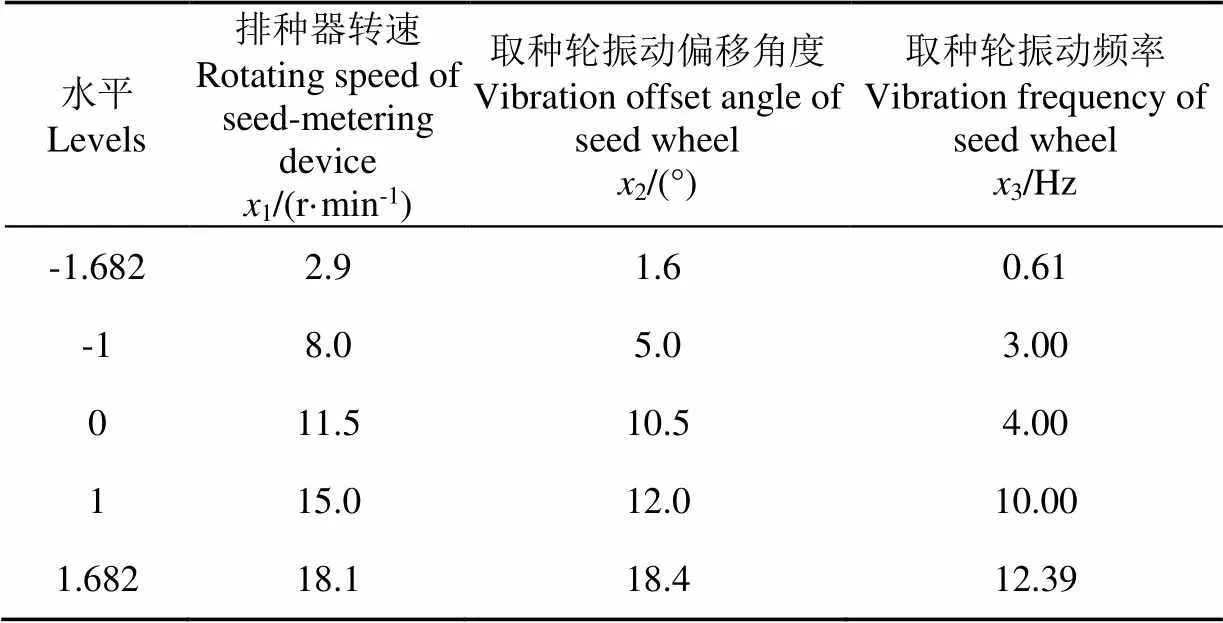
表4 因素水平编码
根据GB/T 6973-2005单粒(精密)播种机试验方法,选取排种粒距合格率1、重播率2、漏播率3为仿真试验指标,其计算公式如下:



式中为试验所统计的棉种总数;1为相邻种子粒距小于0.5倍理论粒距的种子数;2为相邻种子粒距大于1.5倍理论粒距的种子数。试验结果如表5所示,方差分析结果如表6所示。

表5 试验结果
根据表5试验结果,运用Design expert 8.0.6对试验数据进行分析,得出排种粒距合格率1、重播率2、漏播率3与试验因素的编码值回归方程:



决定系数2是判定线性回归直线拟合度的重要指标,通过分析表5可知,排种粒距合格率方程的决定系数为0.97,说明在1的变异中,97%是由1,2,3引起的,重播率的决定系数为0.94,说明在2的变异中,94%是由1,2,3引起的,漏播率的决定系数为0.98,说明在3的变异中,98%是由1,2,3引起的,因此回归方程的预测值与实际值有较高的相关性。
值表示回归参数的影响显著性,由回归模型方差分析表可知,回归项系数1,12,32,22对于排种粒距合格率影响极为显著(<0.01),回归系数2,3,12,23,13对于排种粒距合格率影响不显著(>0.05)。回归系数1,2,12,22,32对于漏播率影响极为显著(<0.01),回归系数3,13,23对于漏播率的影响不显著(>0.05)。回归系数1,12,13,12,22,32对于重播率影响极为显著(<0.01),回归系数2,3,23对于重播率影响不显著(>0.05)。分别剔除模型中的不显著项,回归方程简化为



剔除不显著项后,排种粒距合格率的回归模型中,<0.000 1,决定系数2=0.97,模型极显著,回归方程的预测值与实际值有较高的相关性。漏播率的回归模型中,<0.01,决定系数2=0.94,模型极显著,回归方程的预测值与实际值由较高的相关性。重播率的回归模型中,<0.000 1,决定系数2=0.98,模型极显著,回归方程的预测值与实际值有较高相关性。
响应曲面可以更清晰地反应排种器的排种性能与各因素之间的关系,因此利用Design-Expert 8.0.6软件得到排种器转速、取种轮振动频率、取种轮振动偏移角度对排种器排种粒距合格率、漏播率和重播率的影响曲面,如图10所示。
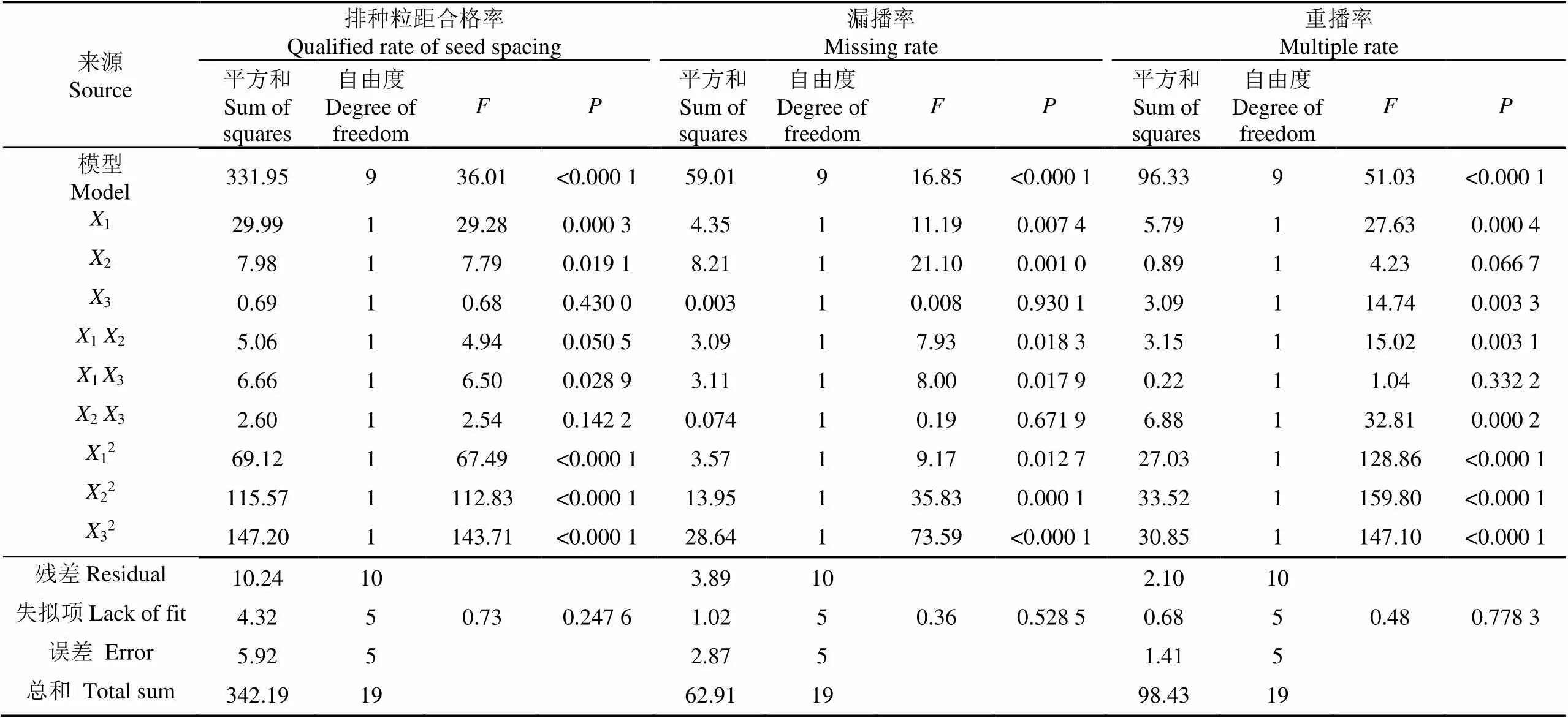
表6 方差分析结果
注:<0.01(极显著),<0.05(显著)。
Note:<0.01 (highly significant),<0.05 (significant).

图10 交互因素对排种粒距合格率的影响
由图10a可知,排种器转速在10~13 r/min、取种轮振动偏移角在7°~10°时,排种粒距合格率较高。当排种器转速一定时,随着取种轮振动偏移角度的增加,排种粒距合格率出现先增加后减小的趋势。当取种轮振动偏移角度一定时,随着排种器转速的增加,排种粒距合格率同样出现先增加后降低的趋势。排种器转速11.5 r/min、取种轮振动偏移角度8.5°时,排种器排种粒距合格率达到最大值。
由图10b可知,当取种轮振动频率为6~9 Hz、取种轮振动偏移角为7°~9°时,排种粒距合格率较高。当取种轮振动频率一定时,随着取种轮振动偏移角的增加,排种粒距合格率出现先增加后降低的趋势。当取种轮振动偏移角一定时,随着取种轮振动频率的增加,排种粒距合格率同样出现先增加后降低的趋势。取种轮振动频率为6.5 Hz、取种轮振动偏移角为8.5°时,排种器排种粒距合格率达到最大值。
由图10a可知,排种器转速在11~13 r/min、取种轮振动频率6~9 Hz时,单粒排种粒距合格率较高。当排种器转速一定时,随着取种轮振动频率增加,单粒排种粒距合格率出现先增加后减小的趋势。当取种轮振动频率一定时,随着排种器转速的增加,单粒排种粒距合格率同样出现先增加后降低的趋势。排种器转速为11.5 r/min、取种轮振动频率6.5 Hz时,排种器的排种粒距合格率达到最大值。
为寻求各因素的最优组合,以排种器排种粒距合格率最大、漏播率与重播率最小为评价指标[31]。对充种性能指标回归模型进行多目标优化求解,优化目标函数与约束条件如下:

将数据带入Design-Expert软件,得到最优工作参数为排种器转速12.59 r/min,取种轮振动偏移角度8.06°,取种轮振动频率6.08 Hz,此时排种器排种粒距合格率达到最高值94.5%,漏播率为2.9%,重播率为3.3%。
5 台架验证试验
为验证优化结果的准确性,根据仿真优化结果所得出的最优工作参数(取种轮振动频率为6.08 Hz,取种轮振动偏移角度8.06°)试制绊齿板,并安装在排种器上进行不同转速下的台架试验。
5.1 试验材料与方法
选取新陆早61号脱绒包衣棉花种子为样本,其千粒质量为90.4 g,含水率为6.3%。试验装置为JPS-12多功能排种试验台,该试验台主要由图像采集装置、传动系统、转轴型孔式棉花精量排种器、排种器固定装置与试验台架等组成(如图11所示)。在试验过程中,取种轮振动频率(6.08 Hz),取种轮振动偏移角度(8.06°)固定不变,分别以8、10、12、13和15 r/min转速进行工作,保证每组试验所测定的取种量为600 粒。

1.图像采集装置 2.传动系统 3.转轴型孔式棉花精量排种器 4.排种器固定装置 5.试验台架
5.2 评价指标
参照GB/T 6973-2005单粒(精密)播种机试验方法,以转轴型孔式棉花精量排种器的排种粒距合格率、漏播率、重播率为性能评价指标,以排种器转速为试验因素,开展单因素试验,排种器转速与仿真试验相同,排种器性能指标及计算方法与仿真试验相同。
5.3 试验结果与分析
为提高试验结果可靠性,对每种转速下的棉种进行3次重复试验,取平均值作为试验结果,如表7所示。
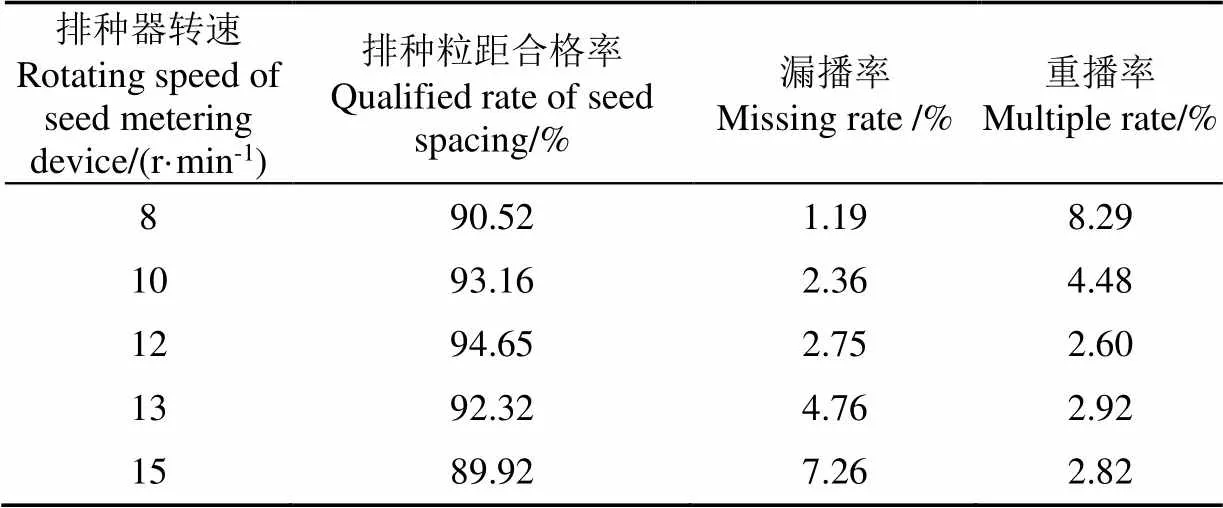
表7 台架试验结果
综上可知,排种器漏播指数随着排种器转速增加呈上升趋势,重播率随着转速增加呈现下降趋势,当排种器转速为12 r/min时,排种器的排种粒距合格率最大值为94.65%,漏播率为2.75%,重播率为2.6%。当排种器排种粒距合格率达到最大值时,台架试验排种器转速(12 r/min)与仿真试验结果(12.59 r/min)误差为5.4%,台架试验和仿真试验结果基本吻合,验证了仿真结果的准确性。
6 结 论
1)以转轴型孔式棉花精量排种器为研究对象,建立棉种充种过程的动力学模型,分析得出在型孔结构参数、排种器结构参数、棉种物理参数已知时,排种器的转速与取种轮的振动频率影响充种概率;对充种区相互抢位的棉种进行力学分析,结果表明,取种轮振动偏移角发生变化时,棉种将获得一定的加速度,增加棉种充入型孔的概率,减少其由于相互抢位造成漏播的概率。
2)采用EDEM仿真软件分析取种轮振动频率对种群法向力的影响,并对充入型孔的棉种速度变化趋势进行分析,结果表明,随着取种轮振动频率增加,种群的平均法向力波动范围增大,相邻法向力峰值的时间间隔缩短,种群扰动增加;相对速度较小的棉种具有更好的充种效果。
3)开展二次回归通用旋转组合试验进行排种器排种性能仿真分析,并对仿真试验结果进行分析与优化,确定排种器的最优工作参数组合为排种器转速12.59 r/min,取种轮振动偏移角度8.06°,取种轮振动频率6.08 Hz。
4)当取种轮振动频率为6.08 Hz、取种轮振动偏移角度为8.06°时,以排种器转速为试验因素开展台架试验,试验结果表明,当排种器转速为12 r/min,排种器的排种粒距合格率达到最大值94.65%,此时漏播率为2.75%,重播率为2.6%,与仿真试验误差为5.4%,漏播率随着排种器转速的增加呈上升趋势,重播率随着转速的增加呈现下降趋势。
[1] 王金武,唐汉,王奇,等. 基于EDEM软件的指夹式精量排种器排种性能数值模拟与试验[J]. 农业工程学报,2015,31(21):43-50.
Wang Jinwu, Tang Han, Wang Qi, et al. Numerical simulation and experiment on seeding performance of pickup finger precision seed-metering device device based on EDEM[J]. Transactions of the Chinese Society of Agricultural Engineering (Transactions of the CSAE), 2015, 31(21): 43-50. (in Chinese with English abstract)
[2] 李沐桐,李天宇,官晓东,等. 锥盘排种器离心推送结构设计与充种机理分析[J]. 农业机械学报,2018,49(3):77-85.
Li Mutong, Li Tianyu, Guan Xiaodong, et al. Design on push structure of centrifugal cone seed metering device and its filling mechanism analysis[J]. Transactions of the Chinese Society for Agricultural Machinery, 2018, 49(3): 77-85. (in Chinese with English abstract)
[3] 王业成,邱立春,张文娇,等. 摩擦型立式圆盘精密排种器的设计与试验[J]. 农业工程学报,2012,28(1):22-26.
Wang Yecheng, Qiu Lichun, Zhang Wenjiao, et al. Design and experiment of friction vertical plate precision seed-metering device[J]. Transactions of the Chinese Society of Agricultural Engineering (Transactions of the CSAE), 2012, 28(1): 22-26. (in Chinese with English abstract)
[4] 刘宏新,徐晓萌,郭丽峰,等. 具有复合充填力的立式浅盆型排种器充种机理[J]. 农业工程学报,2014,30(21):9-16.
Liu Hongxin, Xu Xiaomeng, Guo Lifeng, et al. Research on seed-filling mechanism of vertical shallow basin type seed-metering device with composite filling force[J]. Transactions of the Chinese Society of Agricultural Engineering (Transactions of the CSAE), 2014, 30(21): 9-16. (in Chinese with English abstract)
[5] 杨善东,张东兴,刁培松,等. 侧正压玉米排种器的设计与试验[J]. 农业工程学报,2015,31(增刊1):8-13.
Yang Shandong, Zhang Dongxing, Diao Peisong, et al. Design and experiment of side positive pressure seed metering device[J]. Transactions of the Chinese Society of Agricultural Engineering (Transactions of the CSAE), 2015, 31(Supp.1): 8-13. (in Chinese with English abstract)
[6] 都鑫,刘彩玲,姜萌,等. 自扰动内充型孔轮式玉米精量排种器设计与试验[J]. 农业工程学报,2019,35(13):23-34.
Du Xin, Liu Cailing, Jiang Meng, et al. Design and experiment of self-disturbance inner-filling cell wheel maize precision seed-metering device[J]. Transactions of the Chinese Society of Agricultural Engineering (Transactions of the CSAE), 2019, 35(13): 23-34. (in Chinese with English abstract)
[7] 王奇,朱龙图,李名伟,等. 指夹式玉米免耕精密播种机振动特性及对排种性能的影响[J]. 农业工程学报,2019,35(9):9-18.
Wang Qi, Zhu Longtu, Li Mingwei, et al. Vibration characteristics of corn no-tillage finger-type precision planter and its effect on seeding performance[J]. Transactions of the Chinese Society of Agricultural Engineering (Transactions of the CSAE), 2019, 35(9): 9-18. (in Chinese with English abstract)
[8] 苑进,辛振波,牛子孺,等. 基于RVM的配比变量排肥掺混均匀度离散元仿真及验证[J].农业工程学报,2019,35(8):37-45.
Yuan Jin, Xin Zhenbo, Niu Ziru, et al. Discrete element model simulation and verification of fertilizer blending uniformity of variable rate fertilization based on relevance vector machine[J]. Transactions of the Chinese Society of Agricultural Engineering (Transactions of the CSAE), 2019, 35(8): 37-45.(in Chinese with English abstract)
[9] 王珏,杨欣,王建合,等. 基于离散元法的棉花勺式排种器排种性能模拟[J]. 山东农业大学学报:自然科学版,2016,47(6):873-878.
Wang Jue, Yang Xin, Wang Jianhe, et al. Simulation for performance to seed cotton with scoop-type based on discrete element method[J]. Journal of Shandong Agricultural University: Natural Science Edition, 2016, 47(6): 873-878. (in Chinese with English abstract)
[10] 鲍秀兰,孟亮. 基于离散元法的窝眼式排种器结构优化仿真[J]. 江西农业大学学报,2017(3):186-193,201.
Bao Xiulan, Meng Liang. Structural optimization simulation of nest type seed metering device based on discrete element method[J]. Journal of Jiangxi Agricultural University, 2017(3): 186-193, 201. (in Chinese with English abstract)
[11] 李政权,于建群,张尉林,等. 内充式排种器工作过程和性能的离散元法仿真分析[J]. 农业工程学报,2011,27(11):32-36.
Li Zhengquan, Yu Jianqun, Zhang Weilin, et al. Simulation analysis of working process and performance of inside-filling seed metering device by discrete element method[J]. Transactions of the Chinese Society of Agricultural Engineering (Transactions of the CSAE), 2011, 27(11): 32-36. (in Chinese with English abstract)
[12] 于建群,马成林,左春柽. 组合内窝孔玉米精密排种器清种过程分析[J]. 农业机械学报,2000,31(5):35-37.
Yu Jianqun, Ma Chenglin, Zuo Chuncheng. Analysis of the clearing process of seeds in corn precision metering device with concave metering inner cell[J]. Transactions of the Chinese Society for Agricultural Machinery, 2000, 31(5): 35-37. (in Chinese with English abstract)
[13] 廖庆喜,张朋玲,廖宜涛,等. 基于EDEM的离心式排种器排种性能数值模拟[J]. 农业机械学报,2014,45(2):109-114.
Liao Qingxi, Zhang Pengling, Liao Yitao, et al. Numerical simulation on seeding performance of centrifugal rape-seed metering device based on EDEM[J]. Transactions of the Chinese Society for Agricultural Machinery, 2014, 45(2): 109-114. (in Chinese with English abstract)
[14] 刘涛,何瑞银,陆静,等. 基于EDEM的窝眼轮式油菜排种器排种性能仿真与试验[J]. 华南农业大学学报,2016,37(3):126-132.
Liu Tao, He Ruiyin, Lu Jing, et al. Simulation and verification on seeding performance of nest hole wheel seed-metering device based on EDEM[J]. Journal of South China Agricultural University, 2016, 37(3): 126-132. (in Chinese with English abstract)
[15] 韩丹丹,张东兴,杨丽,等. 基于EDEM-CFD耦合的内充气吹式排种器优化与试验[J].农业机械学报,2017,48(11):43-51.
Han Dandan, Zhang Dongxing, Yang Li, et al. Optimization and experiment of inside-filling air-blowing seed metering device bsed on EDEM-CFD[J]. Transactions of the Chinese Society for Agricultural Machinery, 2017, 48(11): 43-51.
[16] 韩丹丹,张东兴,杨丽,等. 内充气吹式玉米排种器工作性能EDEM-CFD模拟与试验[J].农业工程学报,2017,33(13):23-31.
Han Dandan, Zhang Dongxing, Yang Li, et al. EDEM-CFD simulation and experiment of working performance of inside-filling air-blowing seed metering device in maize[J]. Transactions of the Chinese Society of Agricultural Engineering (Transactions of the CSAE), 2017, 33(13): 23-31.
[17] 孙裕晶,马成林,牛序堂,等. 基于离散元的大豆精密排种过程分析与动态模拟[J]. 农业机械学报,2006,37(11):45-48.
Sun Yujing, Ma chenglin, Niu Xutang, et al. Discrete element analysis and animation of soybean precision seeding process based on CAD boundary model[J]. Transactions of the Chinese Society for Agricultural Machinery, 2006, 37(11): 45-48. (in Chinese with English abstract)
[18] 丁力,杨丽,刘守荣,等. 辅助充种种盘玉米气吸式高速精量排种器设计[J]. 农业工程学报,2018,34(22):9-19.
Ding Li, Yang Li, Liu Shourong, et al. Design of air suction high speed precision maize seed metering device with assistant seed filling plate[J]. Transactions of the Chinese Society of Agricultural Engineering (Transactions of the CSAE), 2018, 34(22): 9-19. (in Chinese with English abstract)
[19] 张昆,衣淑娟. 气吸滚筒式玉米排种器充种性能仿真与试验优化[J]. 农业机械学报,2017,48(7):83-91.
Zhang Kun, Yi Shujuan. Simulation and experimental optimization on filling seeds performance of seed metering device with roller of air-suction[J]. Transactions of the Chinese Society for Agricultural Machinery, 2017, 48(7): 83-91. (in Chinese with English abstract)
[20] 赖庆辉,马文鹏,刘素,等. 气吸圆盘式微型薯排种器充种性能模拟与试验[J]. 农业机械学报,2017,48(5):49-58.
Lai Qinghui, Ma Wenpeng, Liu Su, et al. Simulation and experiment on seed-filling performance of pneumatic disc seed-metering device for mini-tuber[J]. Transactions of the Chinese Society for Agricultural Machinery, 2017, 48(5): 49-58. (in Chinese with English abstract)
[21] 丛锦玲,廖庆喜,曹秀英,等. 油菜小麦兼用排种盘的排种器充种性能[J]. 农业工程学报,2014,30(8):30-39.
Cong Jinling, Liao Qingxi, Cao Xiuying, et al. Seed filling performance of dual-purpose seed plate in metering device for both rapeseed & wheat seed[J]. Transactions of the Chinese Society of Agricultural Engineering (Transactions of the CSAE), 2014, 30(8): 30-39. (in Chinese with English abstract)
[22] 刘彩玲,都鑫,张福印,等. 锥面导流水平盘式小麦精量排种器设计与试验[J]. 农业机械学报,2018,49(12):56-65.
Liu Cailing, Du Xin, Zhang Fuyin, et al. Design and test of cone diversion type horizontal plate wheat precision seed-metering device[J]. Transactions of the Chinese Society for Agricultural Machinery, 2018, 49(12): 56-65. (in Chinese with English abstract)
[23] 廖庆喜,高焕文. 玉米水平圆盘精密排种器排种性能试验研究[J]. 农业工程学报,2003,19(1):99-103.
Liao Qingxi, Gao Huanwen. Experimental study on performance of horizontal disc precision meter for corn seed[J]. Transactions of the Chinese Society of Agricultural Engineering (Transactions of the CSAE), 2003, 19(1): 99-103. (in Chinese with English abstract)
[24] 刘彩玲,王亚丽,都鑫,等. 摩擦复充种型孔带式水稻精量排种器充种性能分析与验证[J]. 农业工程学报,2019,35(4):37-44.
Liu Cailing, Wang Yali, Du Xin, et al. Filling performance analysis and verification of cell-belt rice precision seed-metering based on friction and repeated filling principle[J]. Transactions of the Chinese Society of Agricultural Engineering (Transactions of the CSAE), 2019, 35(4): 37-44. (in Chinese with English abstract)
[25] 高广娣,胡斌,温宝琴,等. 棉花精量穴播器晃动频幅与充种性能的关系[J]. 石河子大学学报:自然科学版,2009,27(4):495-498.
Gao Guangdi, Hu Bin, Wen Baoqin, et al. Relationship between cotton precision dibbler’s filling performance and shake frequency together with range[J]. Journal of Shihezi University: Natural Science, 2009, 27(4): 495-498. (in Chinese with English abstract)
[26] 张涛,刘飞,赵满全,等. 基于离散元的排种器排种室内玉米种群运动规律[J]. 农业工程学报,2016,32(22):27-35.
Zhang Tao, Liu Fei, Zhao Manquan, et al. Movement law of maize population in seed room of seed metering device based on discrete element method[J]. Transactions of the Chinese Society of Agricultural Engineering (Transactions of the CSAE), 2016, 32(22): 27-35. (in Chinese with English abstract)
[27] 黄霞,郑顺义,桂力,等. 基于点云的谷粒高通量表型信息自动提取技术[J]. 农业机械学报,2018,49(4):257-264.
Huang Xia, Zheng Shunyi, Gui Li, et al. Automatic extraction of high-throughput phenotypic information of grain based on point cloud[J]. Transactions of the Chinese Society for Agricultural Machinery, 2018, 49(4): 257-264. (in Chinese with English abstract)
[28] 刘月琴,赵满全,刘飞,等. 基于离散元的气吸式排种器工作参数模拟优化[J]. 农业机械学报,2016,47(7):65-72.
Liu Yueqin, Zhao Manquan, Liu Fei, et al. Simulation and optimization of working parameters of air suction metering device based on discrete element[J]. Transactions of the Chinese Society for Agricultural Machinery, 2016, 47(7): 65-72. (in Chinese with English abstract)
[29] 史嵩,张东兴,杨丽,等. 基于EDEM 软件的气压组合孔式排种器充种性能模拟与验证[J]. 农业工程学报,2015,31(3):62-69.
Shi Song, Zhang Dongxing, Yang Li, et al. Simulation and verification of seed-filling performance of pneumatic- combined holes maize precision seed-metering device based on EDEM[J]. Transactions of the Chinese Society of Agricultural Engineering (Transactions of the CSAE), 2015, 31(3): 62-69. (in Chinese with English abstract)
[30] 王业成,靳亚东,罗嗣博,等. 集排式大豆精量排种器设计与试验[J]. 农业机械学报,2018,49(6):112-118.
Wang Yecheng, Jin Yadong, Luo Sibo, et al. Design and experiment of centralized precision soybean seed-metering device[J]. Transactions of the Chinese Society for Agricultural Machinery, 2018, 49(6): 112-118. (in Chinese with English abstract)
[31] 石林榕,孙步功,赵武云,等. 弹性气吸嘴式玉米滚轮排种器排种性能参数优化与试验[J]. 农业机械学报,2019,50(10):88-95,207.
Shi Linrong, Sun Bugong, Zhao Wuyun, et al. Optimization and verification of performance parameters of elastic air suction type corn roller seed-metering device[J]. Transactions of the Chinese Society for Agricultural Machinery, 2019, 50(10): 88-95, 207. (in Chinese with English abstract)
Simulation analysis and test on the filling performance of rotary type-hole precision seed-metering device for cotton
Li Juanjuan1, Zhang Heping2, Bi Xinsheng1※, Wang Jian1, Hu Bin1, Li Shuzhuo1
(1.832000;2.833200,)
Mechanical precision seedmetering device is widely used in precision seeding technology because of its simple structure and uniform seed metering. Seed filling process is the key link of the whole operation process of seed metering device. The precision metering device is mainly divided into internal filling, side filling, external filling, and the combination of side filling and external filling according to the seed filling mode. In the operation process, the internal filling mode mainly completes the seeding operation through the process of type-hole filling and gravity clearing, and the seed motion parameters close to the type-hole directly affect the seeding quality of the machine. The rotary type-hole cotton precision seedmetering device is a kind of mechanical precision seed metering device. In order to solve the problem of missing seed in the process of filling, the influence of the motion parameters of rotary type-hole cotton precision seedmetering device on the filling performance by establishing the kinematic model of the seed filling process in this paper. Using the discrete element simulation software to analyze the speed change trend of cotton seed falling into the type-hole and the influence of seed wheel vibration frequency on seed group disturbance. Taking the vibration frequency of seed wheel, vibration offset angle of seed wheel and rotating speed of metering device as the test factors, and taking the qualified rate of seed spacing , replaying rate and missing rate as the test indexes, three factors and five levels of positive traffic rotation combined test are carried out to explore the influence of each factor on seed metering performance. Design expert 8.0.6 software is used to analyze the test resultsand optimize the regression model. Single factor simulation test results show that the instantaneous speed of cotton seed increases with the increase of the rotating speed of the seed wheel, the instantaneous speed of the cotton seed is less than that of the seed wheel when it is filled into the type-hole, the cotton seeds with lower relative speed have better filling effect. When the vibration frequency of the seed wheel is 7 Hz, the average value of the normal force of the seed group is the smallest, which is 0.75 N, at this time, the internal friction of the seed goup is the smallest, the cotton seed is easy to be taken by the type-hole, and the seed filling performance of the seed metering device is improved. The simulation results of quadratic regression general rotation combination show that when the rotating speed of the seed metering device is 12.59 r/min, the vibration offset angle of seed wheel is 8.06°and the vibration frequency of seed wheel is 6.08 Hz, the qualified rate of seed spacing reaches the maximum of 94.5%, and the leak seeding rate is 2.9%, the repaly rate is 3.3%. On this basis, the platform validation test was carried out with Xinluzao No.61 cotton seed as the test object. The test results showed thatwhen the rotating speed of the seed metering device was 12 r/min, the maximum qualified rate of the seed spacing was 94.65%, the error between the rotating speed of the seed metering device and the simulation test is 5.4%, which verifies the accuracy of the simulation results. This study can provide a reference for the structural optimizationof the key components of the rotarytype-hole cotton precision metering device.
agricultural machinery; optimization; experiment; EDEM; precision seed metering device; filling performance
2019-9-28
2020-02-26
国家自然科学基金资助项目(51665050)
李娟娟,研究方向为农业机械装备研究。Email:1322314511@qq.com
毕新胜,教授,主要从事现代农业机械设计及理论。Email:bxs_mac@shzu.edu.cn
10.11975/j.issn.1002-6819.2020.05.005
S223.2
A
1002-6819(2020)-05-0038-12
李娟娟,张和平,毕新胜,王 剑,胡 斌,李姝卓. 转轴型孔式精量排种器充种性能仿真分析与试验[J]. 农业工程学报,2020,36(5):38-49. doi:10.11975/j.issn.1002-6819.2020.05.005 http://www.tcsae.org
Li Juanjuan, Zhang Heping, Bi Xinsheng, Wang Jian, Hu Bin, Li Shuzhuo. Simulation analysis and test on the filling performance of rotary type-hole precision seed-metering device for cotton[J]. Transactions of the Chinese Society of Agricultural Engineering (Transactions of the CSAE), 2020, 36(5): 38-49. (in Chinese with English abstract) doi:10.11975/j.issn.1002-6819.2020.05.005 http://www.tcsae.org
